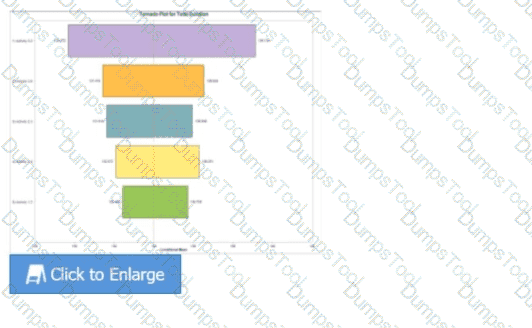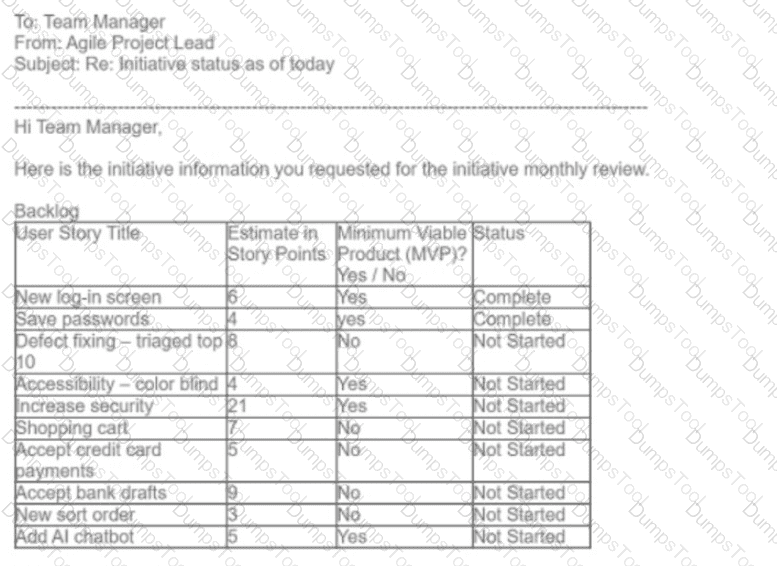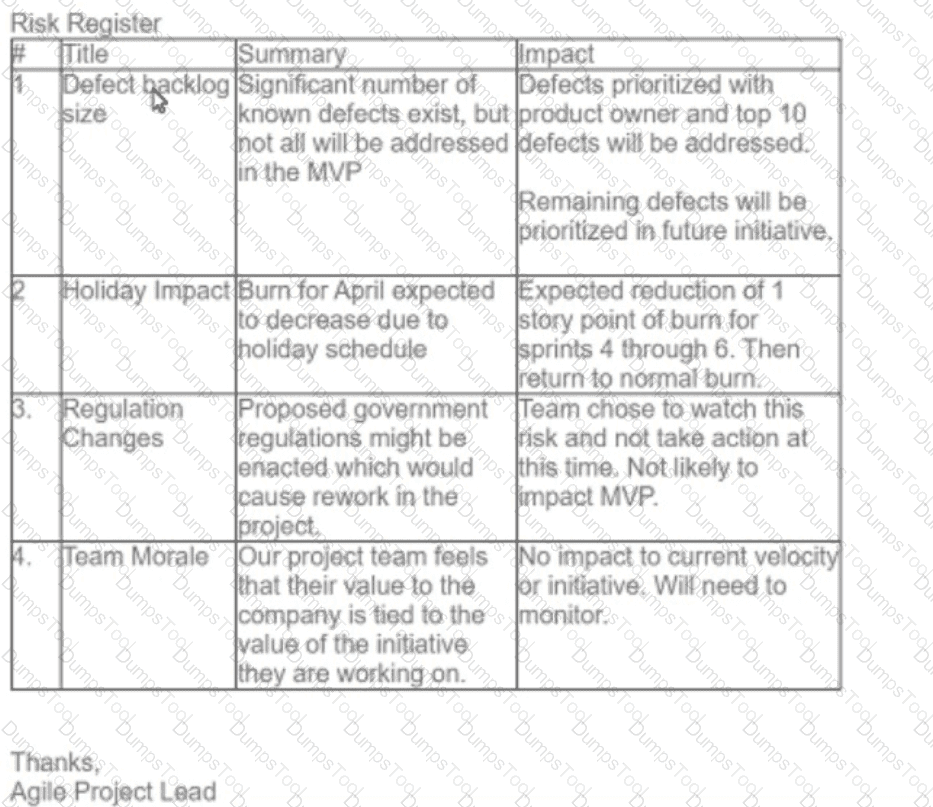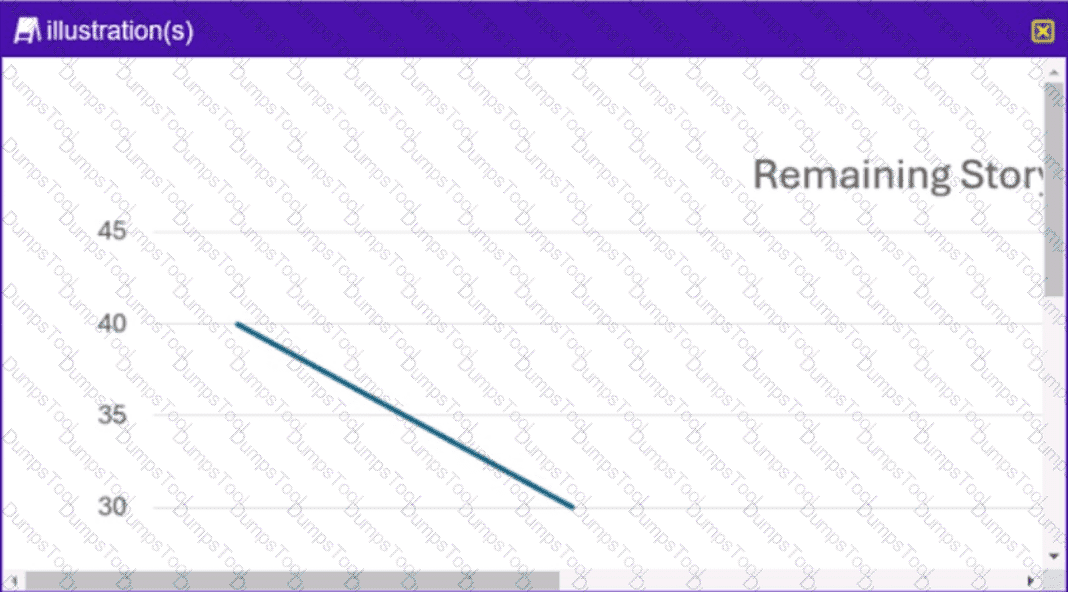An external vendor needs to be contracted to provide additional capacity and expertise to a project team to reduce the probability of delays in a project. The contracts department is raising a concern about confidentiality risks not addressed in the proposed contract and missing from the risk register.
What should the risk manager do next?
A risk manager has been assigned to a new project and learns that stakeholders and project team members are spread across multiple time zones. Furthermore, many project team members have not worked together in the past. These items are identified as potential risks and added to the risk register.
How should the risk manager improve collaboration during risk planning?
During the risk management planning, key stakeholders recommend adding more factors other than probability and the impact to refine the score of prioritized threats in subsequent iterations of the qualitative risk analysis. The stakeholders ask the risk manager to prepare a list to discuss this further.
Which three valid factors should the risk manager prepare on the list for discussion? (Choose 3)
An experienced and the only developer on a software implementation project will be on leave for several weeks. The risk of this critical resource's availability was added to the risk register. Contingencies were made for a support developer to job shadow this resource, depending on how things go prior to their leave. The project team was pleased with the backup plan and the new resource was able to shadow for a few weeks.
What should the risk manager do next?
A project has a significant impact on an organization. Multiple stakeholders expressed concerns regarding the overall project risk during construction of the risk management plan, and they agreed that the risk appetite is low.
What should the project risk manager monitor closely?
A project team is discussing which risk requires more attention and resources for response planning. The team evaluated the schedule to determine which activity had the greatest impact on the project's total duration.
After analyzing the quantitative analysis results, which activity should the team pay more attention to?
Use the chart for the analysis.

Three months into a program, multiple workstreams are showing issues. At this point, the program manager requires that a risk impact assessment be conducted.
What will help calculate the impact?
A risk manager manages risks in a construction project. A stakeholder mentions that if there is less than a 50% chance of rain, construction should continue. Another stakeholder says that if there is less than a 60% chance of rain, construction should continue.
What should the risk manager do next to find out the correct limit?
During a meeting with a project team, a project manager asks a risk manager to determine the risk events that could potentially have the most impact on a 2-year project with a budget of US$800 000. Which approach should the risk manager suggest the project manager take?
The project director and project manager have met with the board and determined that the project has depleted the entire contingency reserve and has started eroding the profit margin.
The project manager would like the risk manager to take full advantage of opportunities.
Which response should the risk manager take?
A risk manager recently had to take an unexpected leave of absence. An interim risk manager has been tasked with completing risk planning for a new project. The interim risk manager has been provided with a strength, weaknesses, opportunities, and threats (SWOT) analysis that was completed during a project kickoff meeting several weeks ago.
What should the interim risk manager do to derive actionable risk responses from the SWOT analysis?
Some project risks are applicable for the project's lifecycle while others risks are only applicable to specific project activities. When should project risks be closed?
While executing an oil extraction project in an environmentally sensitive area, weather is the main cause of delay in the project work. The risk manager was aware that the delays caused by the weather could not be avoided or mitigated.
What should the risk manager do to manage this risk?
A project team identified some risks in a project. Team members became interested in predicting the outcomes of their potential choices following their probability of occurrence.
Which technique should the risk manager use?
A project is evaluating a new software to streamline the current purchase order process. The current process is labor-intensive and involves printing, ink signatures, scanning, and emailing. Several team members gathered cycle time data to gauge the current process and evaluate the new process.
What should the risk manager do next with the data set?
There is confusion among risk action owners on a project about when and under which conditions they should initiate risk responses. Project team members often need to consult with the risk manager to get this conflict resolved.
What should the risk manager do to resolve this recurring situation?
During a project progress meeting, a project team member is concerned that one of the risks has triggered several other low-level risks. These risks should be responded to quickly or there will be severe consequences for the project deliverables.
What should the risk manager do?
The risk manager is facilitating risk planning activities with the team. The team is documenting all the check points along the way that might indicate delays on critical deliverables.
What is this an example of?
A software development project team was preparing for a phased release when an unknown and unexpected risk occurred with potential for delaying one of the features for the planned release. The project team decided to go ahead with the release and address this missing feature at a later date. One of the end users learned about this and strongly opposed the planned release.
What should the risk manager have done to prevent this situation?
A new project is about to start, and the risk manager wants to review some documents that could be relevant for risk identification. Which document will help the risk manager in this process?
A critical piece of equipment broke during a project execution phase. The risk manager notices this risk in the risk register, and the response is to rent equipment until the critical piece is repaired.
What type of risk response is this?
A risk manager wants to determine what risk has the biggest impact on project cost. The risk manager identified three risks, which could occur in different phases of the project.
What should the risk manager do first to understand the impact on project cost?
A risk manager is assigned to a new system deployment project with a strict contractually agreed-on schedule. One of the key risks identified is the availability of experts because many are shared on other strategic projects in the organization.
What should the risk manager do to address this situation?
A highly complex project is about to start Considering that many changes and new information will arise as the work moves forward, key stakeholders are anxious about not addressing risks on time
What should the risk manager do in this situation?
Product testing can be done in multiple ways. A few project team members suggest testing be done in a laboratory environment, whereas others recommend completing the analysis via simu-lation methods. The testing manager has consulted with a peer, who recommends undertaking testing using field trials. The testing manager consults with the risk manager to assess the risk involved in the testing.
Which tool should the risk manager consider for assessing the test risk?
A key project is delayed and all contingency reserves have been used even though the project team has implemented all planned risk responses. What should the risk manager do next?
A risk manager was recently hired to assist with a mid-sized infrastructure project. The risk manager becomes aware that they have an inexperienced project team.
What two items should the risk manager have their team review in order to prepare for an upcoming risk identification workshop? (Choose two.)
During project planning, a risk is identified for which the risk manager has defined a mitigation strategy. Later during project execution, this risk still leaves substantial residual risk.
What should the risk manager do to handle this situation?
A risk manager is preparing risk reports to be included in the monthly status report for project executives. How should the risk manager present the information?
A risk manager has to inform a project sponsor of the expected duration of an entire project. The project has three mam tasks, each with different probabilities of duration.
Which analytical tool should the risk manager use?
At an oil and gas company, a major unified management information system is to be implemented. The project manager noted that risks gathered from the organization's business functions are not properly identified and categorized, making it difficult to develop an effective risk response.
How should the project manager handle this situation?
In the middle of a construction project, the primary construction materials provider canceled the contract and moved to a competitor offering a higher price. The risk manager considers
this a low-impact issue because many construction materials providers can fulfill the project demands. However, after informing the stakeholders of this issue, the major investor is about
to drop their intention to continue executing the project. The risk manager does not understand their decision.
What should the risk manager do next to understand the major stakeholder's decision regarding the project?
The scope of a large mobile network deployment project includes equipment to be furnished by the customer. The risk manager is concerned that the equipment delivery might be delayed, causing additional delays in the project.
What should the risk manager do?
After the initial assessment of a new project, a project manager found that in order to complete the expected results, detailed and exhaustive planning will be required to ensure the product's characteristics and quality. What should the risk manager propose to the project manager what to do?
A project team is overseeing the construction of a new office building. The project is complex, involving multiple contractors, regulatory requirements, and a tight schedule. During a team meeting, the risk manager realizes that a formal risk identification exercise has not yet been conducted.
Given the project's complexity, what should the risk manager do?
A project manager has determined that they cannot outsource work nor eliminate the scope. They also discover that they cannot buy insurance or mitigate the risk.
What should the project manager do?
The project manager performed' a variance analysis on the project during the execution phase. The variances were shown as increasing
What does this result imply?
A project manager is working on a construction project. Based on past experience, the project manager identifies a risk that a supplier of a critical material may not deliver on time. The project manager has already accounted for this risk in the risk management plan. If this risk materializes, the project manager plans to procure the material from a different supplier. A potential risk in this plan is that there may be differences in the material provided by the first and second supplier.
What type of risk is this?
The project’s customer has stated the project must be completed by a date indicated as the P90 date established on the Monte Carlo analysis. What should the project manager do to ensure the P90 date is met?
The stakeholders of a building construction project are not comfortable with the project manager's handling of the project as they believe there is a financial risk. The project manager asks the risk manager to assist in demonstrating to the stakeholders that the project risks are under a tolerable threshold.
What should the risk manager do first to demonstrate this to the stakeholders?
A company has been awarded a large government contract to develop a new transportation system. There is uncertainty surrounding the project's timeline. The project team is struggling to finalize the project's budget due to unclear estimates from vendors. An updated vendor price list detailing the costs of available technologies is an essential component in determining the project's final cost. The project team will not be able to finalize the project's timeline until the budget is finalized.
What should the risk manager do?
In a large enablement project with strict time lines, risks need to be closely monitored. The risk manager publishes reports comparing planned enablement sessions with actual enablement sessions, which help identify potential risks to be addressed.
Which technique is the risk manager using?
A new risk manager is assigned to an ongoing project, what should the new risk manager do first to assess the project environment?
The risk manager of a major project needs to ensure the organizational process assets (OPAsj are updated as a result of risk management activities. How will the risk manager accomplish this?
A project manager identified a risk of communication issues with the client which may impact the project schedule. A member of (he sales team advises that this client prefers face-to- face conversations.
What should the project manager do to avoid this risk?
A risk manager is conducting a qualitative risk analysis for a renewable energy project that faces tight deadlines. The team identifies risks such as weather unpredictability, material cost fluctuations, and potential regulatory delays. While some members advocate prioritizing high-likelihood risks, others emphasize addressing unlikely but high-impact risks.
What should the risk manager do?
A project manager has finished the project charter for a project and has now moved into the planning phase. In the first planning meeting, the project manager is trying to determine the risk tolerance and risk attitudes of the project's key stakeholders.
What is the first resource the project manager should reference?
An organization that spans across different countries undergoes a digital transformation project. The project manager has assigned a risk management team leader who is a risk management certified candidate in their domain.
What should the risk management team leader do in the early stages of the project?
An IT project is 40% complete. During the initial analysis, risks A and B were identified for the project. Risk A has a probability of 0.6 and an impact of US$50.000. Risk B has a probability of 0.7 and an impact of USS60.000. After implementing the planned risk response for risk B. the probability of risk B has been reduced is 0.3.
What is the current project risk exposure?
During a risk reassessment workshop with the project team and some external stakeholders, two key external stakeholders are overemphasizing the impact of a few project risks. This has led to a conflict.
How should the risk manager handle this situation?
A project team's manager is responsible for delivering a specific initiative for the organization. They are preparing for a monthly meeting where the manager will present on the current state of this initiative. The agile project lead sends the manager the following email with the current initiative status (Refer to the email exhibit).



How many total story points is the entire initiative?
A list of risks was identified that could occur during the design phase. Now, the team finished the design phase and those risks did not materialize.
What should the project manager do next?
The project risk manager for an environmental preservation project has started the process of monitoring and controlling risks, The project manager has asked the project team to document the results of this process.
How should this documentation be utilized in the future?
In a large industrial business, an on-going system development project faces a previously identified risk. The risk is adequately managed by the risk manager, however there is still residual risk.
What should the risk manager do?
.
A project manager is identifying risks on a project and decides to use a risk checklist to gather historical data accumulated from similar projects. With several different historical project files to choose from, which two pieces of information should the project manager include in their risk checklist? (Choose two.)
A risk manager has a well-structured risk management process in place for a complex project with a tight schedule. Despite implementing preventive actions, one of the risks identified in the early stages of the project has still occurred and is now an issue.
What should the risk manager do next?
A new project to develop a custom software solution for a high-profile client is being initiated. The project sponsor emphasizes the importance of delivering the solution on time and within budget, as this project could lead to significant future opportunities. The risk manager recognizes that the team lacks a standardized approach to managing risks and that some team members are unfamiliar with risk management practices.
What should the risk manager do?
A risk manager is managing risks of a mission critical application. A subject matter expert (SME) asks the risk manager to treat every single risk identified as an extremely high priority.
What should the risk manager do?
The project team recorded a risk in the risk register indicating that weather-related delays may impact equipment delivery during project execution. When it is time to request the equipment shipment there is bad weather, but the client wants the equipment delivered anyway.
What should the project manager do?
When conducting a risk identification exercise, what two actions should the risk manager take? (Choose two.)
As part of standard procedure to monitor and control a project, a risk manager should constantly update the risk register. The risk register updates should include information on risk reassessment, risk audits, and periodic risk reviews.
What additional information should the risk manager prioritize in the risk register updates?
When processing freight invoices for a project, the project manager notices the shipping costs exceeded the budget due to increased fuel costs. The risk manager included this risk in the project's contingency allowance. When reviewing the project budget execution reports, the project manager notices unused budget remaining in other closed tasks of the project that could cover the additional shipping costs.
What should the project manager do?
A project team has just initiated a large project to move an organization's headquarters to another location. The risk manager has scheduled a risk identification session but notices that the project charter, work breakdown structure (WBS). and scope statement are not available.
What should the risk manager consider?
A major data center initiative involves performing a sensitivity analysis to determine the center's required amount of disaster recovery. Several key stakeholders are in disagreement about which level of disaster recovery is required. The lessons learned disaster recovery plans, and the difference for this data center is its geographical location and unique climate requirements. The database includes examples from previous similar initiatives, as well as the competitor's advertised plans.
What should the risk manager do to quantify the risk?
A core project team is working on unrelated tasks in advance to reduce the risk of delay due to an external team not completing its tasks on time. The core project team has completed all possible unrelated tasks but cannot move forward, because the external team's tasks have yet to be completed.
What should the risk manager do next?
After completing the sprint on an agile project, a team updates the risk burndown chart and notices that risk exposure has increased to levels that could negatively affect project completion. What should the risk manager do to return the project's risk exposure to an acceptable level?
A risk manager has been assigned to an upcoming project. A senior risk manager within the organization recently completed a similar project and has provided a lessons learned document to aid planning efforts for the upcoming project. Upon reviewing the document, the risk manager discovers that the completed project was delivered several months behind schedule and several thousands of dollars over budget. The root cause was determined to be an unforeseen risk trigger that caused several items to be reworked, creating cascading schedule delays and depleting management reserves.
What should the risk manager do to mitigate the chance of the same issues reoccurring?
A project manager is working on a high priority and high profile project. The project team had identified three opportunities, and after analysis, risk responses were recorded. Although risk responses were adequate for the identified opportunities, two of those opportunities were not acted upon. During the risk audit, the project manager found out that several of the planned risk responses were not implemented.
What should the project manager have done to avoid this?
Some issues and unexpected results were found after completing the first phase of a project. The project team is planning the next phase and team members want to avoid the previous issues.
What should the risk manager do to avoid the previous issues?
During the weekly project meeting a risk manager identified new risks in the last sprint, which might impact the project cost by implementing mitigation plans. The sponsor and some project team members do not agree that those risks can impact the project cost.
What should the risk manager do to resolve the sponsor and project team members' concerns about risk identification?
A project team has completed plan risk response activities and has identified three critical risk response plans to major risk events. The responses have been monitored and implemented, with one of the responses presenting the two secondary risks.
What should the risk manager do next?
The risk manager for an IT project developing a software application has a major stakeholder concerned that the project will not conclude within the available funding. The risk manager found delays in the iterations and increments in the project's budget, potentially increasing the duration by two weeks.
What tools should the risk manager use to properly decide the risk of not finishing the project within the budget?
When should the benefits of quantitative risk analysis be weighed against the effort required to ensure that the additional insights and value justify the extra effort?
A risk manager is facilitating a risk identification workshop on a new product with technical experts. There is no consensus among the technical experts on most of the identified risks and their characteristics. The risk manager decides to resolve this difference using another technique.
Which technique should the risk manager use in this situation?